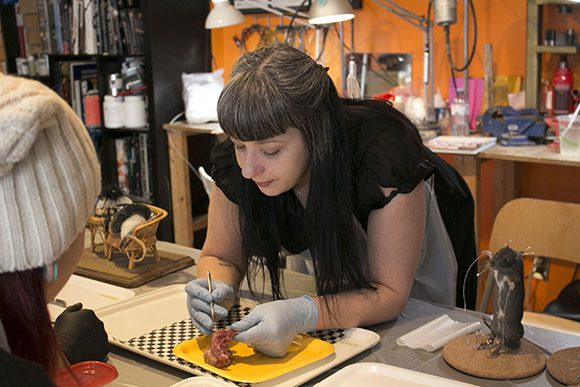Ankixa Risk has a thing for turning dead rats into works of art.
She runs Casual Taxidermy, offering one day workshops for those keen on learning the basics. Classes are $200 per session and are between three and six hours long. She says that the diversity in her students is what surprises her most about the workshops.
“For me it’s really fascinating to see all the different walks of life,” Risk says.
“It’s so across the board. People from all sorts of disciplines and backgrounds. Often it’s people that are out on dates. I’ve had at least five classes where there’s been couples on their dates.”

Ankixa Risk demonstrates how to blow dry a rat, one of the final stages of taxidermy, during her workshop on Jan. 24, 2016.
Risk specializes in anthropomorphic taxidermy, a method that presents animals into human positions. Rats are the perfect size for these types of dioramas. They are also a good starter animal for her students. She gets her rats from Little Ray’s Reptile Zoo in Hamilton. After skinning, the meat is sent back as reptile feeder, ensuring that the practice is ethical and that no animal part goes to waste, a homage to the roots of taxidermy.
During the European exploration of the new world, taxidermy emerged among explorers as a way of preserving the new specimens they discovered. It was not until the Victorian Age that taxidermy was popularized in fashion, crafting and personal collections.
Risk’s foray into taxidermy stems from her childhood.
“I grew up on a dirt road in the country around animals, ” she remembers. “Then we moved to the city when I was in my early teens and I missed being around animals all the time. I think that’s probably how my fascination with seeing dead things started.”
Aside from those who simply want to cross something off their bucket list, Risk says that the taxidermy community in Toronto is on the rise. After 17 years as an interactive software designer, Risk is happy to turn a lifelong fascination into her main artistic focus.

